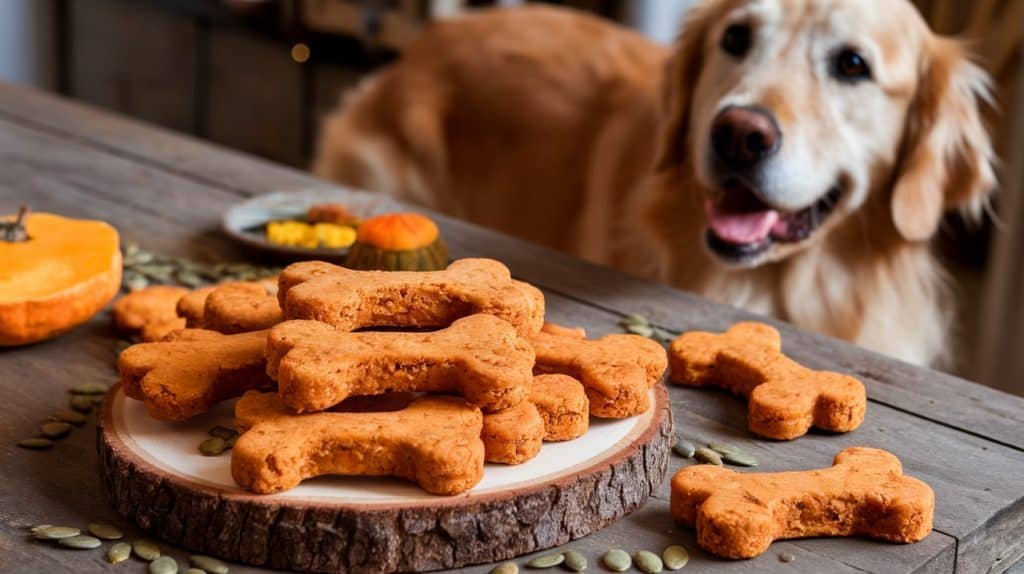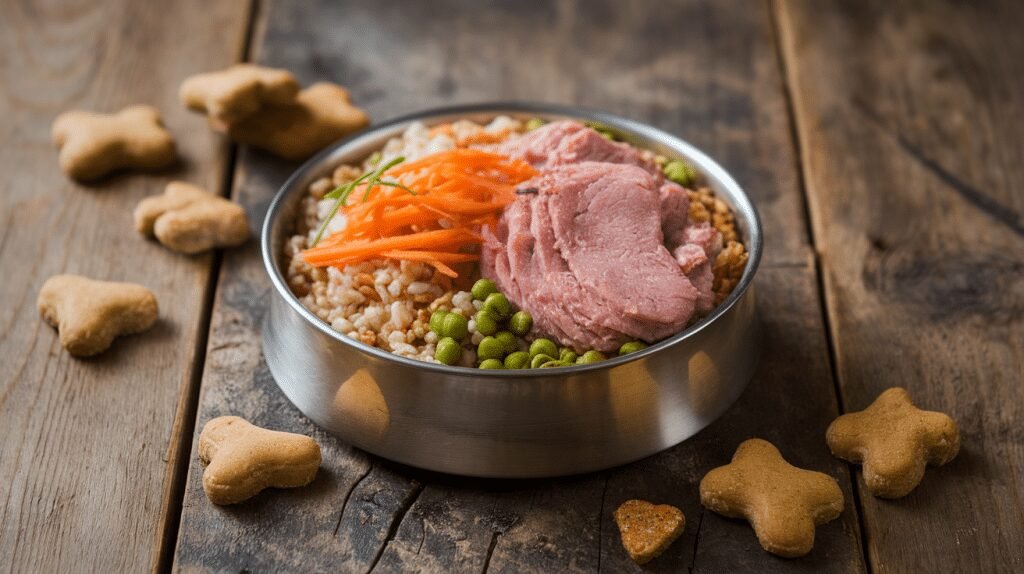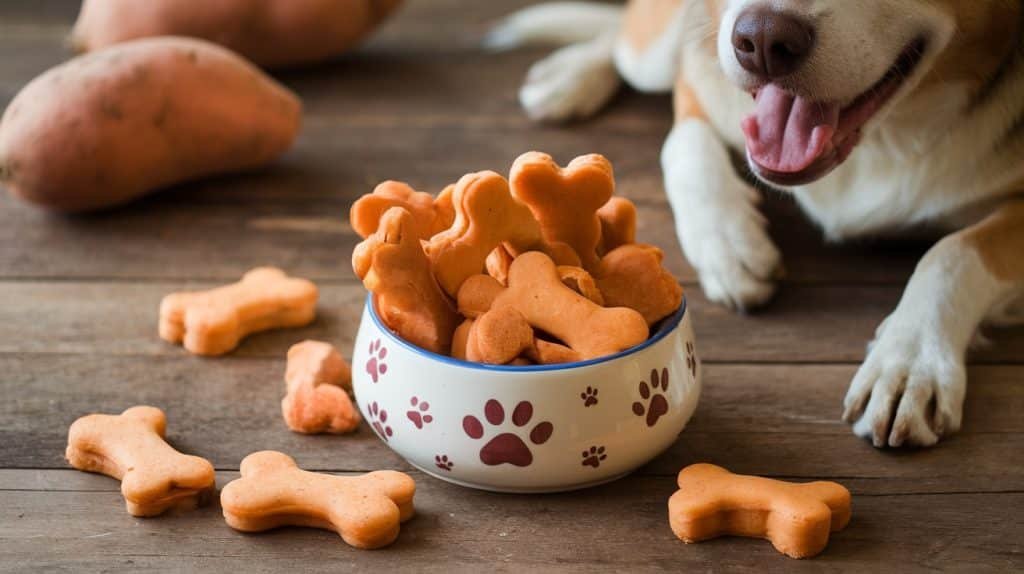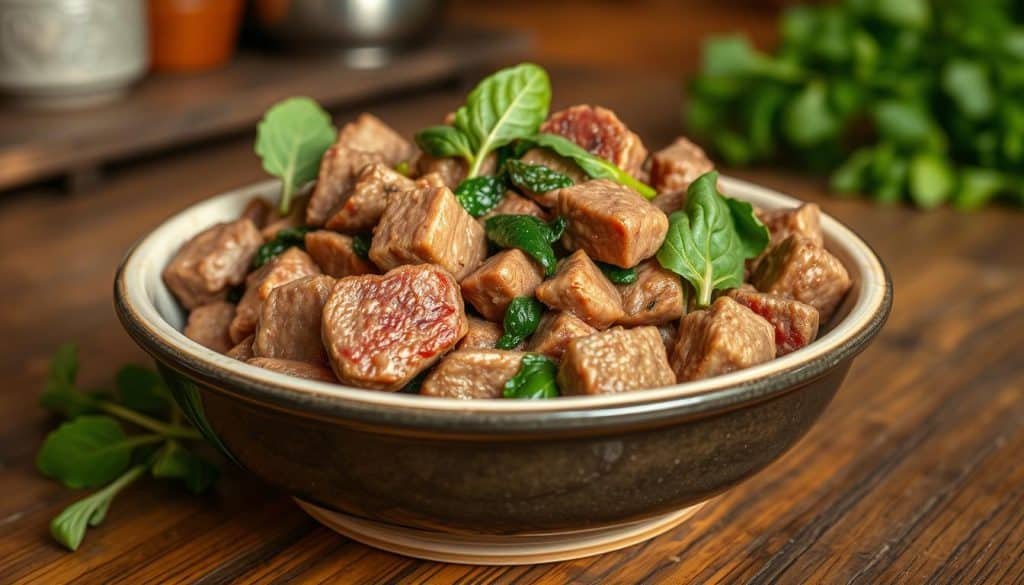
I’ve always loved dogs, and my furry friend Cooper was no exception. I often wondered if I was doing enough to keep him healthy and happy. That’s when I learned about homemade dog food. It made me realize I could control what Cooper ate, avoiding bad ingredients and preservatives.
Research showed me that turkey and quinoa are great for dogs. They make a healthy and tasty meal. This recipe not only filled Cooper’s belly but also made him healthier. In this guide, I’ll share how I made homemade dog food that improved Cooper’s health and happiness.
Why I Chose Turkey and Quinoa for My Dog’s Diet
Choosing the right food for my dog was important. Turkey and quinoa were my top picks. Turkey is a lean protein that’s low in fat. It has essential amino acids for muscle growth and energy.
Turkey is also less likely to cause allergies, which is great for dogs with sensitivities.
Quinoa is a great match for turkey. It’s a complete protein with all nine essential amino acids. It’s full of vitamins and minerals, boosting my dog’s health. Plus, it’s anti-inflammatory and easy on their stomachs.
Together, turkey and quinoa make a balanced diet for my dog. They help him stay healthy and full of energy.
| Ingredient | Benefits |
|---|---|
| Turkey | Lean protein, low in fat, essential amino acids, less allergenic |
| Quinoa | Complete protein, gluten-free, rich in vitamins, anti-inflammatory |
Understanding the Nutritional Benefits of Turkey
Turkey is great for dogs, offering many benefits for their diet. It’s full of high-quality protein, which helps dogs grow strong and lean. This is key for active dogs and those trying to keep their weight in check.
Turkey also has B vitamins like B6 and B12, which help dogs have energy and stay healthy. It has zinc and selenium too, which boost a dog’s immune system. This keeps them healthy and full of energy.
Another big plus of turkey is its low fat content. This helps dogs stay at a healthy weight, especially for those at risk of getting too fat. Turkey also has tryptophan, which can help dogs relax and stay calm, especially when they’re stressed.
Adding turkey to my dog’s meals meets their protein needs and offers many health benefits. Knowing about turkey’s nutritional value helps pet owners make better choices for their dogs.
Benefits of Quinoa for Dogs
Adding quinoa to my dog’s diet has been a great choice for their health. This pseudo-grain is full of nutrients. It has protein, fiber, and amino acids that are good for them. Plus, it’s gluten-free, which is great for dogs with sensitivities.
Quinoa’s fiber helps with digestion and keeps their bowels healthy. It’s also a good choice among healthy grains for dogs. It has magnesium and iron, which help their bodies work better and keep them full of energy.
Quinoa also has antioxidants that fight inflammation. This is a big plus for dogs with health issues. I think adding quinoa to their food makes their diet more balanced and nutritious.
| Quinoa Benefits | Description |
|---|---|
| High Protein Content | Supports muscle and tissue development. |
| Fiber-Rich | Promotes healthy digestion and bowel movements. |
| Gluten-Free | Suitable for dogs with gluten sensitivities. |
| Rich in Minerals | Contains magnesium and iron, contributing to overall health. |
| Antioxidants | Helps reduce inflammation and supports immune function. |
Turkey and Quinoa Dog Food Recipe
Making Turkey and Quinoa dog food at home is rewarding for you and your dog. This recipe has all the nutrients your dog needs. It uses ingredients you can easily find. Follow these instructions to make a healthy meal for your dog!
Ingredients Needed for the Recipe
- 1 pound lean ground turkey
- 1 cup quinoa (rinsed)
- 1 cup carrots (diced)
- 1 cup spinach (chopped)
- 1/2 cup peas (frozen or fresh)
- 4 cups water or low-sodium chicken broth
Step-by-Step Cooking Instructions
- In a large pot, cook the ground turkey over medium heat until it’s browned.
- Add the diced carrots and chopped spinach to the pot. Stir for about 5 minutes until the vegetables soften.
- Incorporate the rinsed quinoa and peas into the mix.
- Pour in the water or low-sodium chicken broth, bringing the mixture to a boil.
- Reduce the heat and cover the pot. Let it simmer for approximately 20 minutes or until the quinoa is fluffy and the water is absorbed.
- Allow the homemade dog food preparation to cool before serving it to your dog.
Prep Time, Cook Time, and Servings
Meal prep for dogs can be easier if you know the prep and cooking details. The Turkey and Quinoa dog food recipe takes about 10 minutes to prepare. Cooking it adds another 30 minutes. So, you’ll spend around 40 minutes from start to finish.
This recipe makes 4-5 servings. The number of servings depends on your dog’s size and needs. It’s important to adjust serving sizes based on your dog’s weight and activity level. For example, active dogs need more food, while less active ones need less.
| Dog Weight (lbs) | Serving Size (cups) |
|---|---|
| 5-10 | 1/2 – 1 |
| 11-20 | 1 – 1 1/2 |
| 21-50 | 1 1/2 – 2 1/2 |
| 51-100 | 2 1/2 – 4 |
By following these guidelines, you can ensure your dog gets the right nutrition and stays healthy. Knowing the cooking times and serving sizes makes meal prep for dogs fun and effective.
How to Store Homemade Dog Food Properly
Storing homemade dog food right keeps it fresh and safe for my pet. Here are some key tips for storing dog food:
- Let the food cool before putting it in airtight containers.
- Store leftovers in airtight containers in the fridge for up to 5 days.
- Freeze portions in freezer-safe bags or containers for up to 3 months. This keeps the food fresh longer.
- Thaw frozen food safely in the fridge overnight or use the defrost setting on a microwave.
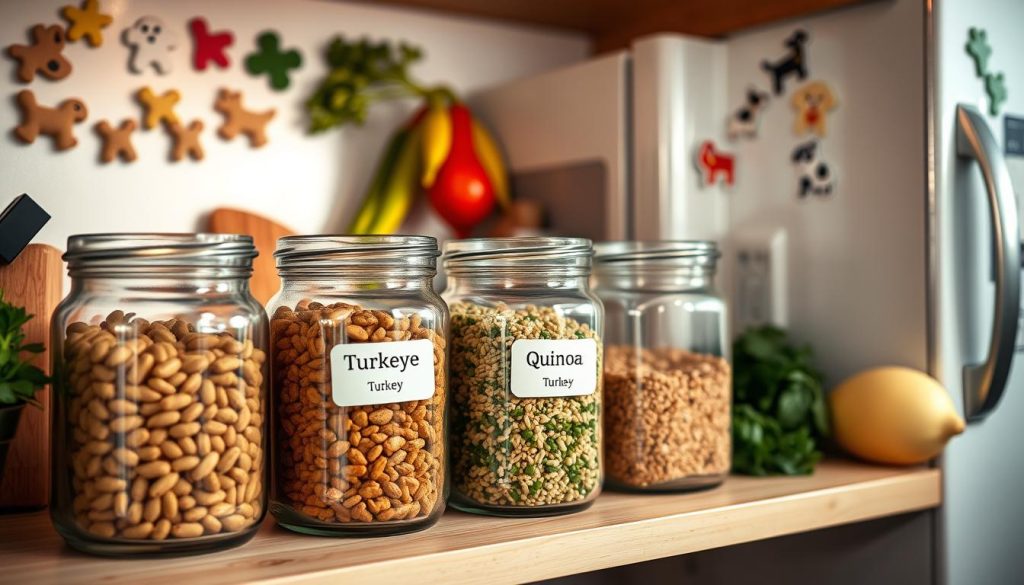
Tips for Introducing New Foods to Your Dog’s Diet
Introducing new dog food can be exciting but also careful. When I change my dog’s diet, I plan carefully to avoid upset stomachs. A slow transition helps my dog get used to the change easily.
I mix the new food with their old one at first. This makes the taste familiar as they get used to it. Here’s a common timeline for changing their diet:
| Day | New Food Ratio | Current Food Ratio |
|---|---|---|
| 1-2 | 25% | 75% |
| 3-4 | 50% | 50% |
| 5-6 | 75% | 25% |
| 7+ | 100% | 0% |
While introducing new foods, I watch my dog closely. I look for signs of allergies or discomfort. Signs include itching, upset stomach, or changes in energy.
By doing this, my dog can slowly enjoy a balanced, homemade diet. I make sure the changes are gentle and watch for any reactions. This way, we both enjoy a healthier lifestyle together.
Additional Healthy Ingredients to Consider
When making homemade meals for my dog, I always seek ways to boost nutrition. Adding healthy dog food add-ins greatly benefits their health. Sweet potatoes, for example, are full of vitamins A and C. These vitamins help keep their immune system strong and their eyes healthy.
Blueberries are another great choice for dog food. They’re full of antioxidants that fight off stress and might even boost their brain power. A few blueberries can be a tasty and healthy treat for them.
Green beans are also a good addition to their meals. They’re low in calories but high in fiber, which helps with digestion. Pumpkin puree is another favorite of mine. It’s not only tasty but also great for their digestive health. Adding these ingredients makes their meals more varied and nutritious.


